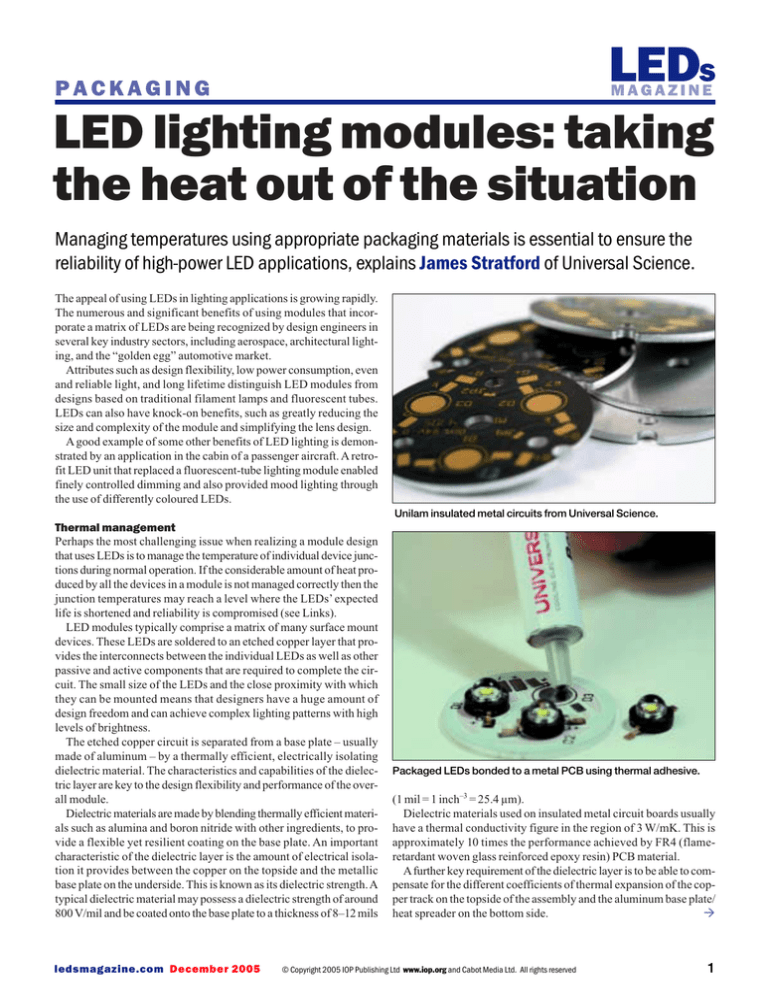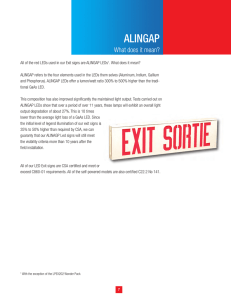
LEDS
LED lighting modules: taking
the heat out of the situation
PACKAGING
MAGAZINE
Managing temperatures using appropriate packaging materials is essential to ensure the
reliability of high-power LED applications, explains James Stratford of Universal Science.
The appeal of using LEDs in lighting applications is growing rapidly.
The numerous and significant benefits of using modules that incorporate a matrix of LEDs are being recognized by design engineers in
several key industry sectors, including aerospace, architectural lighting, and the “golden egg” automotive market.
Attributes such as design flexibility, low power consumption, even
and reliable light, and long lifetime distinguish LED modules from
designs based on traditional filament lamps and fluorescent tubes.
LEDs can also have knock-on benefits, such as greatly reducing the
size and complexity of the module and simplifying the lens design.
A good example of some other benefits of LED lighting is demonstrated by an application in the cabin of a passenger aircraft. A retrofit LED unit that replaced a fluorescent-tube lighting module enabled
finely controlled dimming and also provided mood lighting through
the use of differently coloured LEDs.
Unilam insulated metal circuits from Universal Science.
Thermal management
Perhaps the most challenging issue when realizing a module design
that uses LEDs is to manage the temperature of individual device junctions during normal operation. If the considerable amount of heat produced by all the devices in a module is not managed correctly then the
junction temperatures may reach a level where the LEDs’ expected
life is shortened and reliability is compromised (see Links).
LED modules typically comprise a matrix of many surface mount
devices. These LEDs are soldered to an etched copper layer that provides the interconnects between the individual LEDs as well as other
passive and active components that are required to complete the circuit. The small size of the LEDs and the close proximity with which
they can be mounted means that designers have a huge amount of
design freedom and can achieve complex lighting patterns with high
levels of brightness.
The etched copper circuit is separated from a base plate – usually
made of aluminum – by a thermally efficient, electrically isolating
dielectric material. The characteristics and capabilities of the dielectric layer are key to the design flexibility and performance of the overall module.
Dielectric materials are made by blending thermally efficient materials such as alumina and boron nitride with other ingredients, to provide a flexible yet resilient coating on the base plate. An important
characteristic of the dielectric layer is the amount of electrical isolation it provides between the copper on the topside and the metallic
base plate on the underside. This is known as its dielectric strength. A
typical dielectric material may possess a dielectric strength of around
800 V/mil and be coated onto the base plate to a thickness of 8–12 mils
ledsmagazine.com December 2005
Packaged LEDs bonded to a metal PCB using thermal adhesive.
(1 mil = 1 inch–3 = 25.4 µm).
Dielectric materials used on insulated metal circuit boards usually
have a thermal conductivity figure in the region of 3 W/mK. This is
approximately 10 times the performance achieved by FR4 (flameretardant woven glass reinforced epoxy resin) PCB material.
Afurther key requirement of the dielectric layer is to be able to compensate for the different coefficients of thermal expansion of the copper track on the topside of the assembly and the aluminum base plate/
heat spreader on the bottom side.
© Copyright 2005 IOP Publishing Ltd www.iop.org and Cabot Media Ltd. All rights reserved
1
LEDS
MAGAZINE
ates the need to use connectors and hard wiring. There are several benefits to this, including enhanced reliability resulting from having fewer
junctions and interconnects. Despite the slightly higher cost of the
new materials, the overall cost is reduced because fewer components
are needed, and assembly time is reduced.
Fig. 1. Universal Science’s UniForm technology. Formable metal
circuit boards could be used in bollard lighting applications.
Going three-dimensional
Flat sheets of insulated metal circuit board comprising copper foil, a
dielectric layer and an aluminum base plate have been available for
several years. In the eyes of the forward-thinking LED module
designer, the main problem has been that flat sheets of insulated metal
circuit board limit them to 2D shapes.
To address this limitation, new dielectric materials are becoming
available that have a low modulus, meaning that they are compliant
with mechanical stress and strain. These materials not only accommodate the coefficient of expansion of the metal elements of the construction, but also enable parts to be formed into right angles, and even
through 360˚. This enables designers to realize complex-shaped
designs and ones that form a complete circle with either internal or
external copper traces (figure 1).
When designing with new, formable insulated metal circuit board
materials it is possible to route the tracks around corners, which allevi-
Links
On our website:
Fact or fiction – LEDs don’t produce heat
www.ledsmagazine.com/articles/features/2/5/8/1
2
Strength and durability
LEDs themselves are inherently durable. Mounting them on metalbased circuit boards only serves to enhance their robustness and that
of the finished module, providing excellent resistance to vibration and
mechanical shock.
Automotive lighting clusters provide a good example of how LED
modules can provide superior performance compared with traditional
filament lamps. On-vehicle applications experience high levels of
vibration and wide operating temperature ranges that can cause premature failure of filament lamps. In some operating conditions LEDs
can last up to 100,000 hours, which means that they should not require
any attention for the life of the vehicle.
The long life of LEDs also simplifies the designers’ task because
it is less important to make the lighting module accessible for servicing in the finished product. This can result in a neater, more integrated installation and also in potential cost savings.
Temperature modelling
Thermal analysis software packages are available to help prove LEDbased module designs before they are committed to manufacture.
These software packages gather data from an integrated database about
LED performance and specifications along with those of other devices
that are mounted on the insulated metal circuit board. This data is combined with other information about elements of the design, including
the copper traces, power and ground planes, and vias. The collated
information is then processed to produce an accurate representation
of the thermal performance of the design.
User-friendly graphical representations of the results (figure 2)
enable the design engineer to quickly pinpoint areas that may require
attention, right down to component and track level.
Thermal analysis software can bring significant commercial and
design benefits by helping speed the time to market and reducing the
number of iterations needed to reach a production-ready solution. ●
About the author
James Stratford is the managing director of Universal Science
(www.universal-science.com), a UK-based company that designs
and manufactures a range of thermal materials. Tel: +44 (0)1908
222211, e-mail: sales@universal-science.com.
© Copyright 2005 IOP Publishing Ltd www.iop.org and Cabot Media Ltd. All rights reserved
ledsmagazine.com December 2005




